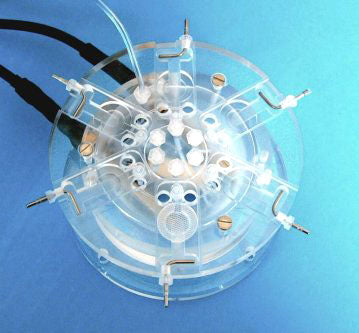KF Technology srl
BSC
BSC
BRAIN SLICE & TISSUE CHAMBERS OVERVIEW
Brain Slice Chamber: Interface and Submerged - BSC 3 - MEMBRANE CHAMBER - MSC1 ......
The BSC1 chamber design is similar to the original "Oslo chamber" (Langmoen & Andersen 1981) with later modifications (Dhanjal & Sears 1980, Alger et al, 1984) to allow both interface and submerged methods of slice maintenance. "Submerged" and "Interface" methods of slice maintenance with same chamber. This chamber allows adaptation to either method of slice maintenance simply by altering the fluid level by means of a screw adjustment device on the chamber. Slices supported on removeable insert adaptable to your requirements. A standard insert having a nylon net is supplied with the chamber for submerged and interface methods
This insert can be modified or custom made to accommodate other preparations eg. adult spinal cord (Dhanjal & Sears 1980, Alger et al, 1984) and Cerebellar slices (Crepel et al 1981).
Optional "Sloped Insert" allows perfusion of slices with a small dead-space
In experiments requiring small dead-space (eg for rapid solution change; use of expensive drugs; obtaining small volumes for fraction collector system etc) a sloped insert is available with the chamber and used in place of the net-type insert. This is arranged to allow perfusion fluid to flow past the slice whilst maintaining a high oxygen tension above it (Murphy et al 1997, Bliss et al 2003). The slope takes the perfusion fluid away to an exit well where it can be collected for re-circulation or analysis
Brain Slice Chamber: Interface
• "Interface" method of slice maintenance
• Dual feed channels for perfusion solution
• Use entire surface for multiple slices or templates
• Single and dual well templates, other designs available upon request
• Single well template has provision for temperature probe and ground wire
• Proportional temperature controller (PTC03) with low noise performance used for heating
*Available separately.
This slice recording chamber is designed to maintain isolated, living tissues in vitro in "interface" mode and allow stable electrophysiological recordings to be made from the preparation. The temperature is controlled by a proportional control heating unit, the PTC03. Please order this item separately
The chamber lower section is similar to the BSC-1 for temperature control and oxygenation. Pre-oxygenated medium enters the main body of the chamber through two separate lines. These are fine bore PTFE tubes which spiral in the heated distilled water in the lower part of the chamber and enter the upper part of the chamber. Here any bubbles in the line break and allow perfusion fluid to flow smoothly towards the slices. Acrylic templates allow the option for use of a single well or two separate wells. (Other designs can be supplied upon request). The templates are positioned on the chamber acrlylic base and silicone grease used to make the seal on the bottom (see diagram below). Typical dead space volume for the single well is approx. 200 ul and each of the wells in the dual version is approx. 100 ul. The length of PTFE tubing carrying the perfusion solution to the wells has a volume of approx. 400 ul. The flow rate of the perfusion fluid is adjusted at the exit well by means of lens tissue which is used to wick solution out of the exit port
By adjusting the "over hang" the flow rate is effectively adjusted and determines the characteristics of the meniscus of fluid around the slice preparation. As with all interface preparations, the high oxygen tension is maintained by bubbling a 95% oxygen, 5% carbon dioxide gas mixture through a ceramic bubbler located in the lower heated part of the chamber. This moistened and warmed gas mixture enters the upper part of the chamber via "port holes" and is then deflected by an acrylic cover across to the centrally located slice preparation. The temperature in the upper chamber is maintained by ensuring that the medium and moistened gas mixture enter at the required temperature. This is dependent on the temperature of the lower chamber body which is warmed by a heating element controlled by the Proportional Temperature Controller, PTC03. An optional monitor sensor allows the upper chamber temperature to be checked when required
The BSC3 is available in 2, 3, 4 and 6 channels versions, and is a cross between the "Oslo" and "Haas" type BSC1 and BSC2 chambers above. This chamber is intended primarily for pharmacological studies as there is little room for electrodes around four or six channels simultaneously
Share


